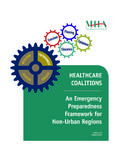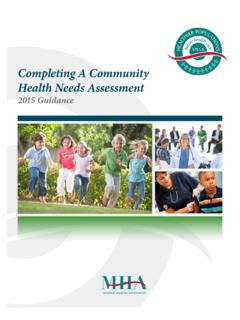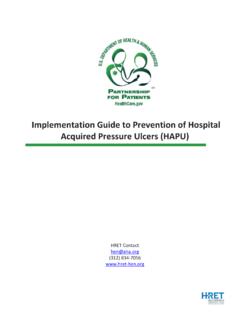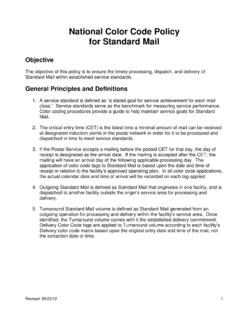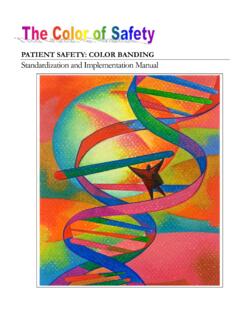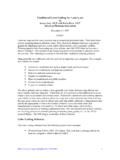Transcription of STANDARDIZED, PLAIN LANGUAGE EMERGENCY CODES ...
1 standardized , PLAIN LANGUAGE EMERGENCY CODESI mplementation GuidexTable of ContentsLetter From the President ..2 Executive Summary ..3 Recommendation ..6 Background ..6 Goals ..6 Principles ..7 Time Line ..7 Rationale ..8 Recommendation ..9 EMERGENCY code Notification: Overhead Paging Versus Silent Notification Systems ..10 Implementation Strategy ..12 Facility Alerts ..16 Weather Alerts ..18 Security Alerts ..20 Medical Alerts ..22 Appendices: ..23 Appendix A: MHA standardized code Workgroup Members ..23 Appendix B: MHA EMERGENCY Preparedness Advisory Committee Members ..24 Appendix C: 2012 MHA EMERGENCY Preparedness Survey: Current EMERGENCY CODES ..25 Appendix D: Hospital Participation Pledge ..27 Appendix E: Sample Hospital Checklist ..28 Appendix F: Sample Hospital Policy ..31 Appendix G: Sample Hospital Competency Checklist ..33 Appendix H: Sample Hospital Poster.
2 35 Appendix I: Frequently Asked Questions ..36 References and Acknowledgements ..38 Table of ContentsImplementation Guide1 Dear Missouri Hospital Chief Executive Officers: As president and CEO of the Missouri Hospital Association, I am pleased that the MHA Board of Trustees endorses the adoption of standardized , PLAIN LANGUAGE EMERGENCY CODES throughout Missouri hospitals and facilities. The use of standardized CODES will increase transparency, reduce patient errors using a simple and practical approach and promote the safety of patients, hospital employees and visitors. The standardized CODES were developed by a workgroup of 30 hospitals and the recommendation of the MHA EMERGENCY Preparedness Advisory Committee. The decision to adopt standardized CODES followed the requests of many Missouri hospitals. In 2012, MHA conducted a survey and found significant variation among hospitals, including nine different EMERGENCY CODES that were used to notify staff of a hospital evacuation.
3 Even in specific geographic regions and metropolitan areas, the variation was significant. Each hospital will need to review the endorsed CODES and determine which are most appropriate for adoption. Although the initiative is voluntary, you are encouraged to consider adoption of all standardized CODES . MHA has provided an implementation guide to assist hospitals with this transition. The goal is to have all Missouri hospitals using these standardized , PLAIN LANGUAGE EMERGENCY CODES by Jan. 1, 2014. Si ncerely, Herb B. KuhnMHA President and CEOSTANDARDIZED, PLAIN LANGUAGE EMERGENCY CODES2 Executive SummaryBackgroundIn mid-2011, the Missouri Hospital Association began receiving requests from its members to lead an initiative to standardize the EMERGENCY CODES used in Missouri hospitals. The requests came from all areas of the state and from health systems, as well as small, rural follows a national trend to standardize EMERGENCY CODES as recommended by the Joint Commission in 2012.
4 Further, there is a trend to adopt PLAIN LANGUAGE versus color code announcements. The adoption of PLAIN LANGUAGE is supported by the following organizations or reports. Department of Health and Human Services Department of Homeland Security The National Incident Management System (2008) The Institute of Medicine s Health Literacy report and recommendations (2004)There is no one definition for PLAIN LANGUAGE , but two criteria are generally recognized. People understand the information received without further extensive explanation. People know what actions are required based on the information 2012 Hospital assessMentBased on these requests, MHA surveyed hospitals about their current code nomenclature and invited participation in a workgroup. Among the 134 hospitals that responded to the survey, representatives from 30 hospitals agreed to serve on the workgroup, and the following information was identified. Four different CODES were used to announce a fire.
5 Seven different CODES were used to announce a medical EMERGENCY . Six different CODES were used to announce an abduction of an infant, child or adult. Seven different CODES were used to announce a severe weather alert. Nine different CODES were used to announce a mass casualty event. Seven different CODES were used to announce a hazardous spill. Nine different CODES were used to announce a hospital evacuation. Ten different CODES were used to announce a security workgroup has been meeting since July 2012 and has established the following objectives and Guide3 Executive SummaryoBJectives for tHe standardized EMERGENCY code Workgroup Reduce variation of EMERGENCY CODES among Missouri hospitals. Increase competency-based skills of hospital staff working in multiple facilities. Increase staff, patient and public safety within hospitals and campuses. Promote transparency of safety protocols. Align, if possible, standardized CODES with neighboring for adopting standardized EMERGENCY codesThe following principles were developed to guide the development of the initiative.
6 This is a voluntary initiative; it is not a mandate to adopt all or any of the recommended EMERGENCY CODES . The recommendations are based on scholarly literature and national safety recommendations. Use of PLAIN LANGUAGE EMERGENCY CODES is the long-term goal of this initiative to ensure transparency and patient and public safety. Minimizing overhead pages in hospitals is encouraged to provide a quieter hospital environment, leading to improved safety and patient str ategyThis voluntary initiative is intended to improve patient and public safety and is not a prescriptive mandate; hospitals are not mandated to adopt all or any of the EMERGENCY CODES . The implementation will be phased in during a one-year time frame. Several hospitals participating in the workgroup have begun using the recommended EMERGENCY will provide resources and guidance to hospitals. Each hospital will need to review these recommendations with their EMERGENCY preparedness committees and hospital leadership and governance.
7 It is important that each hospital carefully consider each EMERGENCY code as a separate issue. It is encouraged, but not required, that a hospital adopt the recommendations for all EMERGENCY , PLAIN LANGUAGE EMERGENCY CODES4standardized, PLAIN LANGUAGE EMERGENCY code recoMMendationMissouri hospitals are committed to ensuring patient and public safety within each hospital facility. The recommendation to adopt standardized EMERGENCY CODES has been developed by experts from hospitals across Missouri and is based on scholarly literature, research and national guidelines. Missouri hospitals are encouraged to adopt the following standardized , PLAIN LANGUAGE CODES to further protect patient and public safety within hospitals and health care facilities. This transition should be completed by Jan. 1, 2014. FACILITY ALERTE ventRecommended PLAIN LanguageAlternate CodeEvacuation Facility Alert + Evacuation + Descriptor (location) NoneFire code Red + Descriptor (location) PLAIN LanguageHazardous Spill Facility Alert + Hazardous Spill + Descriptor (location) code OrangeWEATHER ALERTE ventRecommended PLAIN LanguageAlternate CodeSevere Weather Weather Alert + Descriptor (threat/location) + Instruction NoneSECURITY ALERTE ventRecommended PLAIN LanguageAlternate CodeAbduction Security Alert + Descriptor (threat/location) code PinkMissing Person Security Alert + Descriptor NoneArmed Violent Intruder/Active Shooter/Hostage Security Alert + Descriptor (threat/location) code SilverBomb Threat Security Alert + Descriptor (threat/location) code BlackCombative Patient/Person Security Alert + Security Assistance Requested + (location)
8 NoneMEDICAL ALERTE ventRecommended PLAIN LanguageAlternate CodeMass Casualty Medical Alert + Mass Casualty + Descriptor NoneMedical Decontamination Medical Alert + Medical Decontamination + Descriptor NoneMedical EMERGENCY code Blue + Descriptor (location) PLAIN Languagenote: Because of the widely accepted use of the two color CODES for fire and medical EMERGENCY , the workgroup determined it appropriate to maintain these two color CODES as the primary recommendation, with PLAIN LANGUAGE as the secondary recommendation. Executive SummaryImplementation Guide5 BackgroundIn mid-2011, MHA received several member requests to lead an initiative to standardize the EMERGENCY CODES used to notify staff, patients and visitors. Examples include the EMERGENCY CODES used to announce a fire, abduction, medical EMERGENCY or an armed violent intruder. Based on these requests, in January 2012, MHA included survey questions about current EMERGENCY CODES in its annual EMERGENCY preparedness capacity assessment survey.
9 The results provided evidence of significant variability across the state and even within geographic regions. The following graph illustrates that variability (see Appendix C for the full survey results). MHA staff convened a workgroup representing 30 hospitals of all sizes across Missouri to study national literature, including other state programs, to develop a recommendation for standardized EMERGENCY CODES (see Appendix B for the committee roster). This group provided considerable time and expertise to ensure full consideration of this initiative, including the resources required for implementation. The following recommendation was developed by the MHA standardized EMERGENCY code Workgroup, with input from the MHA EMERGENCY Preparedness Advisory Committee. goalsThe goals of this initiative are to: reduce variation of EMERGENCY CODES among Missouri hospitals increase competency-based skills of hospital staff working in multiple facilities increase staff, patient and public safety within hospitals and campuses promote transparency of safety protocols align, if possible, standardized CODES with neighboring states 020406080100120140 FireMedicalEmergencyAbductionSevere WeatherMass CasualtyHazardous SpillSecurityEvacuationMissouri - Current CodesClear LanguageCode RedCode OrangeCode YellowCode GreenCode BlueCode PinkCode GrayCode WhiteCode BlackCode SilverOther CodeRecommendationCoordinationSource.
10 2012 MHA Member Hospitals Annual EMERGENCY Preparedness Capacity Assessment n = 134 hospitalsSTANDARDIZED, PLAIN LANGUAGE EMERGENCY CODES6principles for adopting standardized , PLAIN LANGUAGE EMERGENCY codesThe following principles were developed to guide the development of the initiative. This is a voluntary initiative; it is not a mandate to adopt all or any of the EMERGENCY CODES recommended. The recommendations are based on scholarly literature and national safety recommendations. Use of PLAIN LANGUAGE EMERGENCY CODES is the long-term goal of this initiative to ensure transparency and patient and public safety. Minimizing overhead pages in hospitals is encouraged to provide a quieter hospital environment, leading to improved safety and patient outcomes. iMpleMentation tiMe lineIt is the recommendation of the workgroup that all participating hospitals adopt the standardized CODES by January 2014. The following implementation time line was developed to support hospitals throughout 2013.
